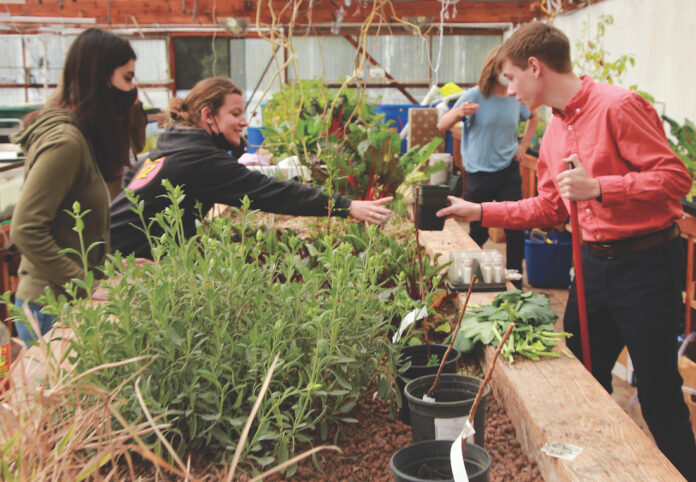The birds are trilling from the dense evergreens. Reggae music wafts from a Bluetooth speaker hanging on a fence behind the San Lorenzo Valley High School football field. Just beyond, a greenhouse is home to innovative studies giving students a leg up in an emerging green career trajectory—aquaponics.
The water-based agricultural style is a business currently valued around $600 million a year, globally. It’s expected to grow by about 15% annually in the coming years.
And Aquaponics is just one of several Career Technical Education (CTE) classes offered at San Lorenzo Valley High in Felton.
On a visit to the campus Tuesday, Howard Meyer, an aquaponics and aquaculture instructor, says the hands-on learning is an effective way to get complex concepts across.
For example, he’s teaching students it’s possible to grow plants using 95% less water than via conventional methods.
At one point the program was even pumping out 500 heads of lettuce a week before they pulled out a couple of rows to provide more space for students.
The aquaponics classes are a case study in food security, he says.
“We were producing food even during the pandemic and the fire,” he said.
When students enter the space, nestled at the edge of wild Santa Cruz Mountain lands, they become part of a self-contained system.
Black soldier flies are raised to feed the fish. The fish excrement provides nutrients to a variety of plants. Water travels continuously from one tank to another, getting purified along the way.
“These are the sponges they use instead of soil,” said SLVUSD Principal Jeff Calden, holding up a baby lettuce seedling to demonstrate how recycling is built into every facet of the coursework.
“It’s just a continuous loop of food,” said aquaculture teacher Dave Grant, who sports a Colorado ball cap and sweatshirt from a nearby lumber company.
Calden explains that the District has been prioritizing the CTE studies, which include a “Green Engineering” construction-based arm, computer science classes, media arts courses and robotics.

The District even partners with UCSC, Cabrillo College and UC Davis, to help take agricultural pathways for students to the next level.
According to Grant, this allows the kids to move seamlessly into post-secondary agricultural science studies, or straight into the work world.
And while technological change has altered many traditional career paths for the worse, large companies like Walmart have been investing in aquaponics, the teachers note.
The greenhouse also plays host to elementary classes, as younger learners get a taste of the full course offerings ahead of them.
Felton’s unique education branch couldn’t have gotten off the ground without the help of the local supporters, says Calden.
“The community chipped in bigtime,” he said, pointing to the support of hardware businesses that donated materials and volunteers who donated their time to build the facility.
Now it’s a factory of green growing.
If pests like aphids arrive, teachers show students how to spray them off, without harmful chemicals, for example.
“We like to say it’s better than organic,” Meyer said. “The fish are our fertilizer.”
Some of the most recent developments on the farm? On the banana trees in the corner—they use the leaves for packaging—tiny bunches of fruit have begun to appear. They’re getting into the shrimp business, too.
“We’ve got new tanks right here that we’re setting up,” Meyer said, motioning to empty blue cylinders that look like rain barrels.
And, Calden reveals, they’re making preparations to restart a farmers’ market.
They already sell eggs from the chickens further back on the property (part of a county effort to monitor for emerging pathogens), but they don’t necessarily make it past the teacher’s lounge.
“The bottom line is the CTE programs allow for a different kind of class,” Calden said. “There are students that learn better in this environment than a classroom environment.”
Grant says he loves watching how students take pride in their work.
“I think there’s a lot of value to kids having a sense of accomplishment,” he said. “I think all kids should take CTE.”
The students are “held accountable” for the effort they put in, he adds.
“You can’t have a C+ fish tank,” Grant said. “If it takes you longer—it’s still gonna get done.”
Marketing even comes into play, as students are taught to conceptualize what the food will ultimately be used for.

Meyer says he’s looking forward to a new building, now under construction, which will be home to a new greenhouse and a classroom area. The CTE programs allow the students to put into practice the lessons they’ve been learning in their other classes, he added.
“There’s chemistry, there’s math—there’s everything here,” he said of the aquaponics program—joking about how the local university is following in Felton’s footsteps. “UCSC’s starting a program. Even though we were first—that’s okay.”
Between the aquaculture pond with the koi and catfish, and the one with the trout and koi, Claire Ersunay, 17, is hanging out with a group of classmates.
She comes to aquaponics three times a week, she said. But she’s also part of the “health careers” CTE program, where she heads to Harbor High School in Santa Cruz to learn about the medical field.
The Ben Lomond junior says it’s pretty useful to have such niche classes.
“I learn a lot,” she said. “I know a lot more about fish and how the ecosystem works.”
On the other side of the standing semi-circle is Liam Debus, an 18-year-old senior, from Felton.
He’s also an unpaid intern for the aquaponics program.
“We have near-total independence in what we work on,” he said. “The system also sustains itself.”
Ashton Reedy, 17, a junior from Ben Lomond, said he likes how the aquaponics program is project-based.
“We’ve been cleaning out tanks and ponds,” he said. “It’s one of the highlights of my day.”
Reedy knows if he pays attention and applies himself, it could even lead to a good job one day.
Plus, he says, one of the benefits—after you get your tasks done, is you get to hang out with your friends.










